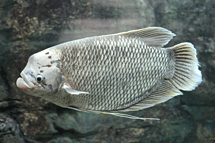Alerts
Please be advised that our bird aviaries are open!
Your Toronto Zoo is committed to the health and safety of the animals in our care. We take proactive steps to protect our birds from Avian Influenza which has been confirmed in a wild bird in southern Ontario, and some birds may still be off display.
Please note Splash Island is still closed and will not open until July due to unforeseen delays in construction. Please watch for updates on https://www.torontozoo.com/tz/splash or on our social media pages. Thank you!
Please note the following animals are currently not on display due to various reasons including Avian Bird Flu, and Covid-19 sensitivity:
- Flamingo, peacock, owl, bald eagle, and aviaries
- Some Kids Zoo Animals
- Cougar
- Moose
- Kangaroo walk through (kangaroos are still visible)
- Axolotl
We apologize for the inconvenience!


Fish
Location at the Zoo:
Malayan Woods
Region: Indomalaya
Jumbo gourami
Reaches a maximum length of 60 cm, which makes this the largest fish in the family. The body is deep, strongly compressed, and covered with ctenoid scales (thin, round scales with comb like projections (ctenii) on the exposed edge). The pelvic fins are long; the dorsal fin is positioned on the posterior of the body. Males can be distinguished by the dorsal and anal fins, which are more pointed, whereas the females' fins are more rounded. Many males also develop a noticeable bump on the forehead which becomes enlarged as they age and also darkens in colour. In fully mature breeding males it is almost black. Juvenile fish are brownish-red in colour with thin vertical bands. The bright colouration fades with age, turning dull grey.Conservation Status: IUCN
